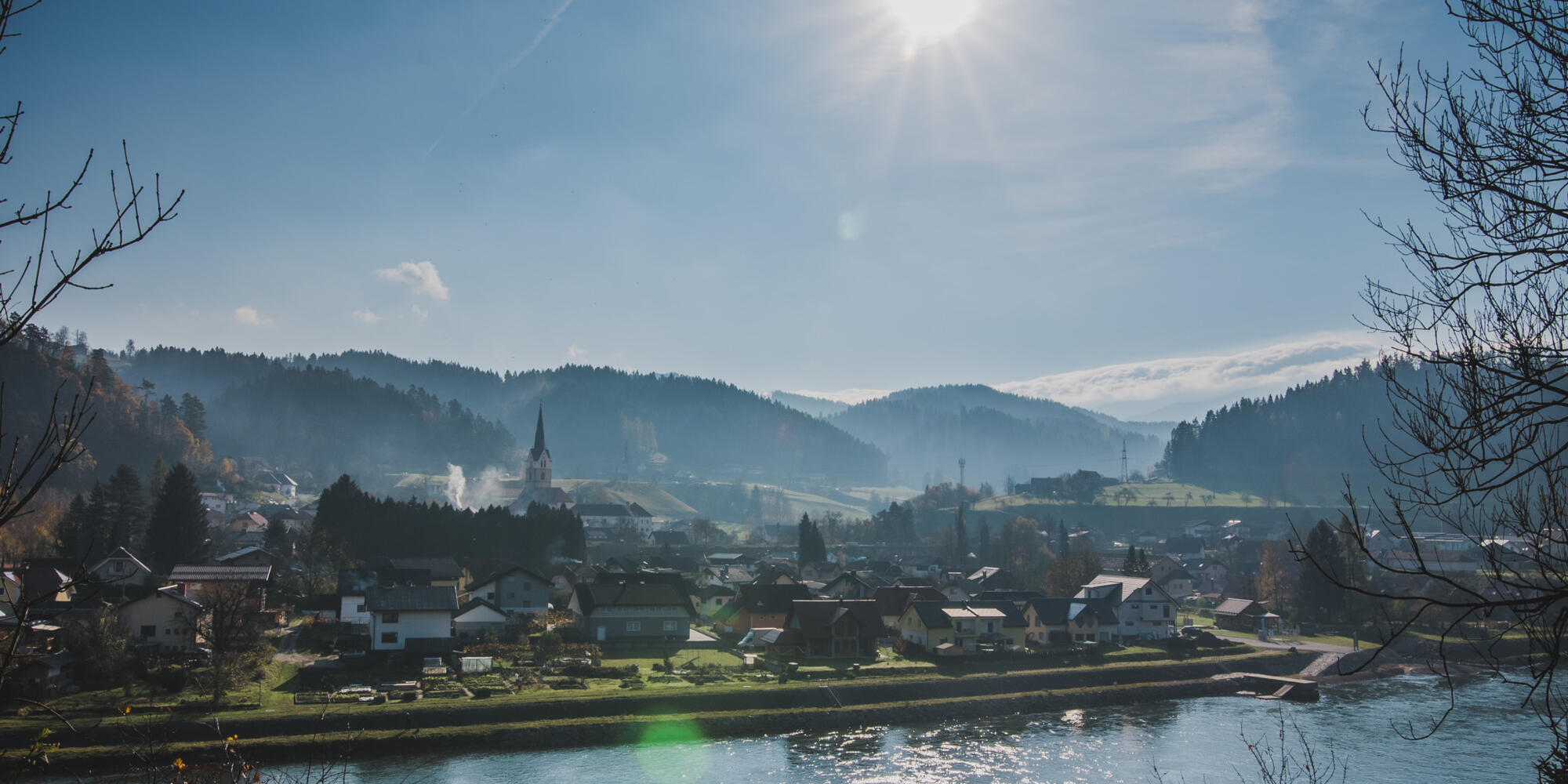
Vuzenica
Vuzenica lies at the confluence of Drava and its affluent Cerkvenica, under the north slope of the forest-covered Pohorje. The valley provides some wonderful views of Pohorje, with an even more gorgeous view from the top of Pohorje. Vuzenica is renowned as one of the oldest town in the Drava Valley. In the past, rafters launched their “flosa” from here, while hauliers transported their goods along the Drava River. There were also numerous fairs organised here in the past, a tradition that has been preserved to this day.
In Vuzenica, you can take a trip by bicycle, on a horse, or on foot, experiencing nature in all its glory. Numerous climbs are worth the effort, always rewarding with wonderful views. We must also mention the parish church of Saint Nicholas, first mentioned in 1238. In the 19th century, specifically between 1838 and 1844, the Bishop of Lavant Anton Martin Slomšek, a poet and a staunch advocate of Slovene national culture, also worked in Vuzenica. He worked as an archbishop, dean, and school supervisor, writing the textbook Blaže ino Nežica v nedeljski šoli.
Cultural heritage
Memorial room of Bishop Anton Martin Slomšek
In the current library and vestibule of the Vuzenica parish, the memorial room of Bishop Anton Martin Slomšek, who served in Vuzenica between 1838 and 1844, is preserved. The special feature of the room is a well-preserved painted ceiling dating to 1653, which depicts minute patterns, objects and scenes from everyday life. Among other, there are also entries in German and Latin.
Church of St. Nicholas
The former raft protector shows an older past. The church stood in the centre of today’s Vuzenica already in the beginning of the 12th century and has retained the artistic elements of all stylistic periods to this day. Its largest feature is the massive eastern choir belfry, while the beauty of the interior is lauded by the Gothic vaults and frescoes further to six Baroque altars and several Baroque paintings on canvas. The image of the church is complemented by a large horse-shoe like rectory, a house on a living rock. It had grown since the 14th century until Slomšek held the office of the priest in the past century. It houses a unique wooden painted ceiling from the 17th century.
Church of St. John the Baptist
The church was built in Šentjanž nad Dravčami in the 14th century. It has a uniform interior and maintains a simple monolithic look, which is the heritage of the Romanesque architecture. Such characteristics have been preserved in Gothic branch churches. The architectural purity of the wall screamed to be painted, which was entrusted to skilful masters around 1445. The frescoes are of top quality and show the excellence of those who ordered it. The random representation of the bishop on the northern wall under the scenery of the Three King's Trips is probably also not a coincidence, while the depiction of the donors is placed on the southern wall, which is painted with scenes from the legend of St. John the Baptist.
Pistro Castle
In today's ruins, except for the modest remains of the masonry above the cliff, only a Renaissance defence tower is preserved. The tower is one-storey, built with a mixture of stone and bricks, and what is unusual is that the floor has a trapezoidal shape, and on the outer side, facing the potential enemy, strongly rounded edges.
The Church of Virgin Mary on the Stone
The Church of Virgin Mary on the Stone is a pilgrimage church and a true architectural pearl that was returned to its former glitter by the appropriate restoration interventions. The church was first mentioned in 1383, although it was built at least a few decades earlier. Josip Mravljak wrote an interesting legend about its creation that says that Virgin Mary saved a young pilgrim, who was condemned by the Lord of the castle, from death. However, regardless of the legend, it can be assumed that due to its position, it was connected with the nearby mansion and its chaplain, who even had benefice, and was also the chaplain of the castle. The excellent status of the church is reflected also in the equipment, which had to be more ambitious than the present, as can be deduced from the preserved late Gothic sculpture of Christ's birth. The preserved reliefs in the fragment date back to the period from 1510 to 1515. What paintings kept the Gothic statue - probably not the only one - company, is yet to be established.
Kremzer Museum of Antiquities
The technical museum of the Kremzer family is located in a renovated commercial building. The rich collection of technical items and vehicles is worth seeing and is interesting for all generations.
Railway viaduct
Via the Cerkvenica Valley, on the Maribor-Dravograd-Klagenfurt railway, a magnificent stone railway bridge adorns Vuzenica, a viaduct with 7 semi-circular arches. The stone is from the local quarry. The bridge was built in 1862 and renovated in 2006.
Natural heritage
River Drava
The municipalities of the Upper Drava Valley will take advantage of the numerous opportunities offered by the Drava River. The idea stems from the tradition that the Drava River had been a central economic space for centuries, which ended with the establishment of the power plants. The rafters have shown a new opportunity to revitalize the Drava River and at the same time the tourist offer. With the “Drava River as an opportunity” project the municipalities of Dravograd, Vuzenica, Muta, Radlje ob Dravi and Podvelka want to re-establish the traffic along the Drava River and the rafting relation. In addition to the construction and arrangement of rafting ports, boathouses, road connections and ambience, some municipalities will also get a new tourist infrastructure.
Forest Learning Path
The northern slope of Pohorje that descends from Kop to the Drava River is characterized by large forestry. People were strongly attached to the forest and depended on it for decades. The rich Pohorje forests enabled the development of ironworking and glass industry in the past. The Forest Pistro Castle path, which is well tended, is just one of many walkways. It is intended for those who want to learn about the forest, its structure, development, or steal moments of relaxation and rest in the forest. The path also passes the cultural and historical monuments, which only enriches our knowledge, behaviour and experiences of the forest. It gives everyone as much as they want to see and accept. The inscription boards along the route and the guide are only of help to make the familiarization with the forest easier.
Sedovnik's linden tree
Sedovnik's linden tree is the oldest linden tree planted, supposedly by the Turks. It is about 500 years old and has the circumference of 8 meters.
Services nearby (10km)
To spletno mesto uporablja piškotke, ki izboljšajo vašo izkušnjo. Kaj so piškotki?
Nastavitve piškotkov
To spletno mesto uporablja piškotke, ki izboljšajo vašo izkušnjo. Kaj so piškotki?
Zahtevani piškotki
Ti piškotki so nujni za delovanje naše spletne strani in jih ni mogoče izključiti.
Analitični piškotki
Omogočajo anonimizirano zbiranje podatkov o obisku spletne strani. Nastavi jih lahko tretja oseba, katere storitve uporabljamo.

 Warnings
Warnings
 Construction
Construction
 Weather
Weather
 Contact
Contact
 Search
Search











